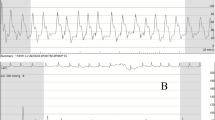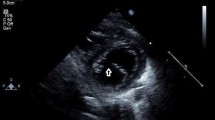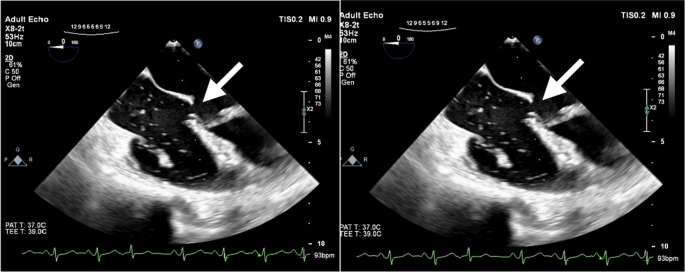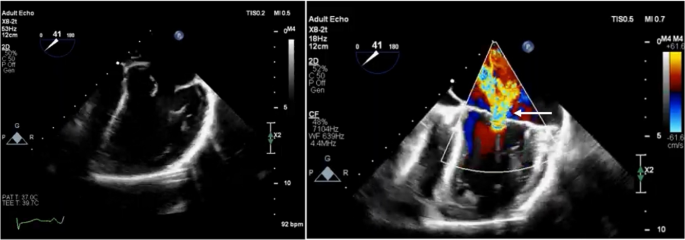Abstract
Background
Cleft in the mitral valve leaflet is a primary cause of congenital mitral regurgitation, stemming from developmental anomalies in the mitral valve and frequently associated with other congenital heart defects. Concurrent presence of cleft in mitral valve leaflet with atrial septal defect and ventricular septal defect is relatively rare. Echocardiography, especially transesophageal echocardiography, is essential in diagnosing cleft mitral valve leaflet and related congenital heart defects, providing critical, detailed imagery for accurate assessment. This study presents a young female patient whose anterior mitral cleft, along with atrial septal defect and ventricular septal defect, was revealed through three-dimensional transesophageal echocardiography.
Case presentation
A 25-year-old Iranian female, experiencing progressive dyspnea and diminished physical capacity over 3 months, was referred to our hospital. Initial examination and transthoracic echocardiography indicated severe mitral regurgitation. Further evaluation with transesophageal echocardiography corroborated these findings and identified a cleft in the anterior mitral valve leaflet, coupled with mild left ventricular enlargement and significant left atrial enlargement. The complexity of the patient’s condition was heightened by the diagnosis of cleft mitral valve leaflet in conjunction with atrial septal defect and ventricular septal defect, showing the complex nature of congenital defects.
Conclusion
This case emphasizes the critical role of transthoracic echocardiography in diagnosing cleft of mitral valve leaflet and associated cardiac anomalies, showcasing its superiority over transthoracic echocardiography for detailed visualization of cardiac structures. The identification of multiple congenital defects highlights the necessity for a comprehensive diagnostic approach to manage and treat patients with complex congenital heart diseases effectively. Future research should aim to refine diagnostic methodologies to enhance patient outcomes for cleft of mitral valve leaflets and related congenital conditions.
Similar content being viewed by others
Explore related subjects
Discover the latest articles, news and stories from top researchers in related subjects.Introduction
Cleft mitral valve leaflet (CMVL) represents the predominant cause of congenital mitral regurgitation (MR), a condition characterized by improper closure of the mitral valve, leading to backward flow of blood from the left ventricle into the left atrium. Originating from congenital anomalies in the mitral valve’s development, specifically mitral hypoplasia, CMVL frequently coexists with other congenital heart defects. The most common of these are atrioventricular septal defects, which underscore the complex nature of congenital cardiac anomalies [1,2,3,4,5,6].
The clinical manifestation of CMVL varies widely, with the severity of MR ranging from mild to severe. In its initial stages, particularly in younger patients, CMVL may only induce mild MR, often going undetected owing to the absence of significant symptoms. However, as patients age, the severity of MR can escalate, leading to more significant cardiac complications [3, 7].
Echocardiography is essential for diagnosing mitral valve anomalies, but transthoracic echocardiography (TTE) has limitations [8,9,10,11]. Transesophageal echocardiography (TEE), however, offers a more direct and detailed view of the mitral valve and cardiac structures, overcoming the shortcomings of TTE and providing crucial imaging for identifying complex cardiac abnormalities such as CMVL, atrial septal defect (ASD), and ventricular septal defect (VSD) [12,13,14,15].
In this report, we explore the case of a young female patient presenting with severe symptoms of MR. Utilizing TEE, we identified not only an anterior mitral cleft but also concurrent ASD and VSD, illustrating the complex interplay of congenital defects in patients with CMVL.
Case presentation
We report the case of a 25-year-old female Iranian patient who was referred to our clinic with 3-month history of progressive dyspnea and limitations in daily activities. The patient described a gradual onset of symptoms, which had increasingly interfered with her ability to perform routine tasks.
Upon initial evaluation, the patient appeared in mild distress due to dyspnea. Other vital signs were within normal limits, with a blood pressure of 110/70 mmHg and a heart rate of 90 beats per minute. Physical examination was notable for a 2–3/6 grade holosystolic murmur best heard at the left sternal border, suggesting valvular heart disease as a potential underlying cause.
Given the clinical presentation and the physical examination findings, the patient underwent a TTE to further evaluate the suspected valvular pathology. In the TTE evaluation, the findings were as follows: The ejection fraction (EF) was 55%, indicating preserved systolic function. There was mild left ventricular enlargement with left ventricular end-diastolic volume index (LVEDVI) of 69 cc/m2. Severe left atrial (LA) enlargement was noted, with left atrial volume index (LAVI) of 48 cc/m2. The mitral valve (MV) appeared myxomatous, with suspicion of the flail of the posterior mitral valve leaflet (PMVL), leading to MR evidenced by two distinct regurgitant jets. Additionally, moderate tricuspid regurgitation (TR) was observed.
Following the initial diagnostic evaluation with TTE, which suggested severe MR among other findings, a comprehensive TEE was performed to enable a more detailed assessment of the mitral valve anatomy and associated cardiac structures. The procedure was carried out under local anesthesia and mild conscious sedation, following proper preparation and draping of the patient.
The TEE findings corroborated some of the TTE results and provided additional insights into the patient’s cardiac condition. Mild left ventricular enlargement was confirmed, with LVEDVI of 69 cc/m2, and EF remained stable at 55%, indicating preserved systolic function. Severe LA enlargement was observed, with LAVI of 48 cc/m2, consistent with the volume overload from severe MR. Small size primum ASD (6 mm) with a left-to-right shunt and a tiny perimembranous VSD were also observed. The MV was noted to be thickened with a cleft in the anterior mitral valve leaflet (AMVL). Moderate TR was also noted. The pulmonary to systemic flow ratio (Qp:Qs ratio) was 1.1 (Figs. 1, 2, 3, 4).
Despite the Qp:Qs ratio being below 1.5 with no significant shunt, indicating no significant right-to-left shunt, the patient was a candidate for surgery owing to the presence of severe MR caused by a cleft, and EF below 60%.
Discussion
Clefts, which are narrow openings or imperfections, are believed to stem from a partial manifestation of an endocardial cushion defect, primarily affecting the anterior mitral valve leaflet, with a frequency of 1:1340 in children. In adults, this condition is rare and accounts for 33% of congenital mitral valve regurgitation cases [16, 17]. However, if the atrioventricular junction is intact and MR is minor, individuals can remain symptom-free for an extended period, and the mitral cleft might be discovered incidentally [8]. Although cleft is the primary cause of MR, it is frequently exacerbated by anterior leaflet restriction and annular dilatation. The degree of regurgitation is the result of interactions between the papillary muscles, accessory chordal attachment, left atrium, and free wall of the left ventricle [7, 8].
Several instances of mitral cleft have been documented. For example, Mohammadi et al. described a case involving a woman experiencing heart failure symptoms during her eighth decade of life. A more detailed investigation uncovered a rare occurrence of clefts in both anterior and posterior segments of the mitral valve [17]. Similarly, Muller et al. reported on a unique case featuring isolated multiple mitral clefts, with the patient having two clefts in the posterior and one in the anterior segment of the mitral valve [18]. The term “isolated mitral cleft” refers to a condition where the mitral valve cleft exists without any association with an atrioventricular septal defect or a common atrioventricular junction [19].
One important aspect of defects is their co-occurrence with other congenital anomalies. As an example, partial anomalous pulmonary venous connection (PAPVC) is often associated with ASD. PAPVC can be isolated or occur with other cardiac congenital diseases, including ASD, VSD, or PDA. The type and location of PAPVC can influence the severity of symptoms and the likelihood of associated anomalies. For example, PAPVC with superior anomalous drainage is frequently associated with superior sinus venosus ASD, while PAPVC with inferior anomalous drainage is often linked to inferior sinus venosus ASD. Accurate diagnosis and early management are crucial to address complex cardiac anomalies and optimize outcomes.
Echocardiography stands as the premier choice for imaging when evaluating congenital anomalies of the mitral valve, providing intricate details on the valve’s anatomy and morphology, as well as the mechanism and extent of mitral regurgitation. While two-dimensional (2D) echocardiography might present challenges in assessing mitral clefts, three-dimensional (3D) echocardiography can offer a more detailed and sophisticated analysis of the valve’s three-dimensional structure [1]. Three-dimensional echocardiography enhances the visualization of the mitral leaflets and annulus, the subvalvular apparatus, and their spatial relationships with surrounding structures, offering real-time anatomical views of the mitral valve [20].
The integration of 2D and 3D echocardiography techniques is particularly beneficial for diagnosing clefts and providing precise guidance for repair surgeries. Surgeries informed by this combined echocardiographic approach have demonstrated a high success rate of 93% [21, 22]. In the case under discussion, echocardiography played a crucial role in diagnosing the cleft.
In our study, although an experienced echocardiographer performed TEE, it is essential to consider the utility of magnetic resonance imaging (MRI) in identifying congenital abnormalities. MRI demonstrates significant advantages over TEE in this regard. Its superior spatial resolution and excellent soft tissue contrast allow for detailed visualization of complex anatomical structures and small intracardiac lesions [23,24,25]. MRI provides a comprehensive, three-dimensional view of the heart and surrounding structures, free from the limitations of acoustic windows that affect TEE, facilitating a more holistic assessment of both cardiac and extracardiac anomalies. Additionally, MRI is noninvasive, which makes it safer and more patient-friendly, particularly for pediatric patients. Unlike TEE, which is invasive and can cause discomfort and risks such as esophageal injury, MRI offers a more comfortable and risk-free alternative for patients [26, 27].
This study highlights a rare case of AMVL with ASD and VSD, illustrating the importance of detailed imaging. However, its nature as a single case report limits the ability to generalize the findings. While TEE was essential for the diagnosis, it may not be available in all settings.
Conclusion
Conducting thorough cardiac imaging, particularly through TEE, is crucial for identifying valvular abnormalities, especially in specific patients presenting with symptoms suggestive of significant valvular pathology. While TTE is an initial and valuable screening tool, TEE offers enhanced visualization and can reveal pathologies that may be missed or inadequately characterized on TTE alone.
In the case presented, the patient’s symptoms of severe MR prompted initial evaluation with TTE, which provided valuable information but did not fully outline the other coexisting cardiac abnormalities. However, TEE, with its superior spatial resolution and ability to obtain closer proximity to the heart structures, offered a more detailed assessment, revealing additional abnormalities.
Data availability
The data of the current study are available on reasonable request from the corresponding author.
Abbreviations
- ASD:
-
Atrial septal defect
- CMVL:
-
Cleft mitral valve leaflet
- EF:
-
Ejection fraction
- LA:
-
Left atrial
- LAVI:
-
Left atrial volume index
- LVEDVI:
-
Left ventricular end-diastolic volume index
- MR:
-
Mitral regurgitation
- PMVL:
-
Posterior mitral valve leaflet
- TEE:
-
Transesophageal echocardiography
- TTE:
-
Transthoracic echocardiography
- TR:
-
Tricuspid regurgitation
- VSD:
-
Ventricular septal defect
References
Yuan X, Zhou A, Chen L, Zhang C, Zhang Y, Xu P. Diagnosis of mitral valve cleft using real-time 3-dimensional echocardiography. J Thorac Dis. 2017;9(1):159–65.
Tamura M, Menahem S, Brizard C. Clinical features and management of isolated cleft mitral valve in childhood. J Am Coll Cardiol. 2000;35(3):764–70.
Fraisse A, Massih TA, Kreitmann B, Metras D, Vouhé P, Sidi D, et al. Characteristics and management of cleft mitral valve. J Am Coll Cardiol. 2003;42(11):1988–93.
Hill MC, Kadow ZA, Long H, Morikawa Y, Martin TJ, Birks EJ, et al. Integrated multi-omic characterization of congenital heart disease. Nature. 2022;608(7921):181–91.
Pavlicek J, Gruszka T, Kapralova S, Prochazka M, Silhanova E, Kaniova R, et al. Associations between congenital heart defects and genetic and morphological anomalies. The importance of prenatal screening. Biomed Pap Med Fac Univ Palacky Olomouc Czech Repub. 2019;163(1):67–74.
Douedi S, Douedi H. Mitral regurgitation. StatPearls. Treasure Island (FL): StatPearls Publishing; 2024.
Timóteo A, Galrinho A, Fiarresga A, Branco L, Banazol N, Leal A, et al. Isolated cleft of the anterior mitral valve leaflet. Eur J Echocardiogr. 2007;8(1):59–62.
Minardi G, Leonetti S, Bernardi L, Pulignano G, Pino PG, Boccardi L, et al. An isolated anterior mitral leaflet cleft: a case report. Cardiovasc Ultrasound. 2010;8:26.
Huang SJ, McLean AS. Appreciating the strengths and weaknesses of transthoracic echocardiography in hemodynamic assessments. Cardiol Res Pract. 2012;2012: 894308.
Malik SB, Chen N, Parker RA 3rd, Hsu JY. Transthoracic echocardiography: pitfalls and limitations as delineated at cardiac CT and MR imaging. Radiographics. 2017;37(2):383–406.
Omerovic S, Jain A. Echocardiogram. StatPearls. Treasure Island (FL): StatPearls Publishing; 2024.
Biswas A, Yassin MH. Comparison between transthoracic and transesophageal echocardiogram in the diagnosis of endocarditis: a retrospective analysis. Int J Crit Illn Inj Sci. 2015;5(2):130–1.
Si X, Ma J, Cao DY, Xu HL, Zuo LY, Chen MY, et al. Transesophageal echocardiography instead or in addition to transthoracic echocardiography in evaluating haemodynamic problems in intubated critically ill patients. Ann Transl Med. 2020;8(12):785.
de Bruijn SF, Agema WR, Lammers GJ, van der Wall EE, Wolterbeek R, Holman ER, et al. Transesophageal echocardiography is superior to transthoracic echocardiography in management of patients of any age with transient ischemic attack or stroke. Stroke. 2006;37(10):2531–4.
Patel JK, Glatz AC, Ghosh RM, Jones SM, Ravishankar C, Mascio C, et al. Accuracy of transesophageal echocardiography in the identification of postoperative intramural ventricular septal defects. J Thorac Cardiovasc Surg. 2016;152(3):688–95.
Zegdi R, Amahzoune B, Ladjali M, Sleilaty G, Jouan J, Latrémouille C, et al. Congenital mitral valve regurgitation in adult patients. A rare, often misdiagnosed but repairable, valve disease. Eur J Cardiothorac Surg. 2008;34(4):751–4.
Mohammadi S, Bergeron S, Voisine P, Desaulniers D. Mitral valve cleft in both anterior and posterior leaflet: an extremely rare anomaly. Ann Thorac Surg. 2006;82(6):2287–9.
Müller H, Kalangos A, Fassa AA, Lerch R. Isolated cleft mitral valve with posterior and anterior clefts: a rare cause of congenital valve regurgitation. Echocardiography. 2010;27(5):E50–2.
Hammiri AE, Drighil A, Benhaourech S. Spectrum of cardiac lesions associated with isolated cleft mitral valve and their impact on therapeutic choices. Arq Bras Cardiol. 2016;106(5):367–72.
Leye M, Beye SM, Dioum M, Coly SM, Affangla DA, Ba DM, et al. Asymptomatic mitral regurgitation caused by an isolated mitral leaflet cleft in a young adult: a case report. World J Cardiovasc Dis. 2022;12(2):118–22.
Muratori M, Berti M, Doria E, Antona C, Alamanni F, Sisillo E, et al. Transesophageal echocardiography as predictor of mitral valve repair. J Heart Valve Dis. 2001;10(1):65–71.
Miglioranza MH, Muraru D, Mihaila S, Haertel JCDA, Iliceto S, Badano LP. Isolated anterior mitral valve leaflet cleft: 3D transthoracic echocardiography-guided surgical strategy. Arquivos Bras Cardiol. 2015;104:e49–52.
Gatti M, D’Angelo T, Muscogiuri G, Dell’aversana S, Andreis A, Carisio A, et al. Cardiovascular magnetic resonance of cardiac tumors and masses. World J Cardiol. 2021;13(11):628–49.
Rajiah PS, François CJ, Leiner T. Cardiac MRI: state of the art. Radiology. 2023;307(3): e223008.
Pushparajah K, Duong P, Mathur S, Babu-Narayan S. Educational SERIES in congenital heart disease: cardiovascular MRI and CT in congenital heart disease. Echo Res Pract. 2019;6(4):R121–38.
Ahmed K, Lal Y, Condron S. Esophageal perforation: a rare complication of transesophageal echocardiography in a patient with asymptomatic esophagitis. Case Rep Gastroenterol. 2012;6(3):760–4.
Pong MW, Lin SM, Kao SC, Chu CC, Ting CK, Tsai SK. Unusual cause of esophageal perforation during intraoperative transesophageal echocardiography monitoring for cardiac surgery—a case report. Acta Anaesthesiol Sin. 2003;41(3):155–8.
Acknowledgements
None.
Funding
None.
Author information
Authors and Affiliations
Contributions
A.A. and S.F.H. diagnosed and treated the patient. E.A.S. and S.N. identified the patient’s record and drafted the manuscript. R.Y. designed the graphics and drafted the manuscript. All authors read and approved the final manuscript.
Corresponding authors
Ethics declarations
Ethics approval and consent to participate
The study was approved by the institutional board review at Tehran University of Medical Sciences and was assigned the ethics code IR.RHC.REC.1397.084.
Consent for publication
Written informed consent was obtained from the patient for publication of this case report and any accompanying images. A copy of the written consent is available for review by the Editor-in-Chief of this journal.
Competing interests
The authors declare that they have no competing interests.
Additional information
Publisher’s Note
Springer Nature remains neutral with regard to jurisdictional claims in published maps and institutional affiliations.
Rights and permissions
Open Access This article is licensed under a Creative Commons Attribution-NonCommercial-NoDerivatives 4.0 International License, which permits any non-commercial use, sharing, distribution and reproduction in any medium or format, as long as you give appropriate credit to the original author(s) and the source, provide a link to the Creative Commons licence, and indicate if you modified the licensed material. You do not have permission under this licence to share adapted material derived from this article or parts of it. The images or other third party material in this article are included in the article’s Creative Commons licence, unless indicated otherwise in a credit line to the material. If material is not included in the article’s Creative Commons licence and your intended use is not permitted by statutory regulation or exceeds the permitted use, you will need to obtain permission directly from the copyright holder. To view a copy of this licence, visit http://creativecommons.org/licenses/by-nc-nd/4.0/.
About this article
Cite this article
Alizadehasl, A., Amini-Salehi, E., Jebelli, S.F.H. et al. Presentation of mitral valve cleft with concurrent atrial septal defect and ventricular septal defect detected by three-dimensional transesophageal echocardiography: a case report. J Med Case Reports 18, 387 (2024). https://doi.org/10.1186/s13256-024-04704-y
Received:
Accepted:
Published:
DOI: https://doi.org/10.1186/s13256-024-04704-y








